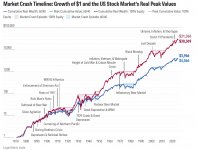A little more on DOW.
Comparing it to a recent successful turnaround stock, MMM.
On the 3 year chart DOW held a pretty decent lead through the first two years, but interestingly, DOW's drop and MMM's bounce happened at pretty much the exact same time. Through 3 year's MMM is now up 40% while DOW is down 40%.
Zoom out to the 5 year chart and the 2 stocks are basically dead even at basically no gain, or loss, for either. Which I again find interesting. Though of course as both provide strong dividends, both are in the green on total returns over that time.
My dad worked for DOW for 38 years and still has a bunch of stock (not just DOW but also a few spin-offs after the merger with DuPont.....IIRC). From Morningstar:
Dow's Low-Cost Production Should Generate Long-Term Profit Rebound Despite Near-Term Uncertainty
Apr 24, 2025
Dow Chemical is one of the largest chemicals producers in the world, producing key components for a broad range of industrial and consumer chemical and plastic products. The company’s history spans over 125 years and features an evolving product portfolio. In its current form, Dow is the commodity chemicals company created in 2019 from the DowDuPont merger and subsequent separations.
The majority of Dow’s production capacity resides in North America, where it benefits from low-cost natural gas-based feedstocks. This allows Dow to manufacture at a significant cost advantage to marginal cost producers that rely on higher-cost crude oil-based feedstocks to make the same products. Dow’s commodity chemicals are generally priced off of the marginal cost of production. Low natural gas prices and high oil prices have led to substantial profits for firms operating in North America, and we expect this dynamic will persist.
Over half of Dow’s customer base comprises the plastic packaging and polyurethane industries, with the other half are well diversified between several industrial and consumer end markets. The firm is especially focusing on consumer packaging, infrastructure, and automotive markets to drive revenue expansion. Dow’s strategy is to grow profits through incremental operational improvements. The company’s growth capital expenditures have been allocated toward capacity expansions and efficiency improvements that will enhance profitability over time.
Over the long run, Dow plans to widen its circularity initiatives, which aim to use plastics as feedstock for its manufacturing operations. The company is improving its recycling capabilities through partnerships with Mura Technology and Valoregen. Construction of the requisite recycling facilities will take at least 10 years, so the firm’s circularity initiatives will ramp up gradually. However, these projects will help Dow capitalize on rapidly accelerating demand for more environmentally friendly products as a result of evolving regulations and consumer preferences.
Fair Value and Profit Drivers
We reduce our fair value estimate to $50 from $65 following Dow's first-quarter earnings. The decrease is due to our lower near- and medium-term outlooks driven by lower prices and volume, and higher input costs, all of which will weigh on profits. We forecast a profit decline in 2025, marking the third straight year of falling profits. Our forecast assumes an economic slowdown in 2025 as a result of tariff-related inflation and trade disruption.
We forecast top-line growth will average around 1% per year through 2029. Dow's asset-heavy commodity chemicals manufacturing plants are subject to a high degree of operations leverage. As a result, plant capacity utilization is a key profit driver. Even in a favorable cost environment, reduced volume can still drive margin contraction due to high operating leverage. Longer term, we forecast firmwide operating margins will expand to nearly 11% over the next five years, up from less than 5% in 2024 as demand normalizes and Dow's efficiency initiatives take hold.
As a commodity chemicals manufacturer, Dow's profitability is also impacted by evolving feedstock costs. Most of the company's products see prices change based on Brent crude oil price movements as marginal-cost producers used oil-based naptha feedstock. Around 75% of Dow's production capacity sits in North America and is made from natural-gas-based feedstocks. As a result, a good directional indication of Dow's profits is changes to the oil-to-gas ratio, calculated as the price of Brent crude oil divided by the price of Henry Hub natural gas. A ratio above 7 times implies a comparative cost advantage according to the EIA. Our midcycle forecasts for Brent oil ($60 per barrel) and Henry Hub natural gas ($3.30 per million British thermal units) imply the oil-to-gas ratio will average around 18 times.
In a scenario where we see a prolonged economic slowdown from tariff-related stagflation, gas prices would remain elevated, while Brent oil prices would fall. We assume sharply reduced exports creates oversupply in North America and weighs on all producer volumes. In this scenario, we assume revenue declines at an average 1% per year while midcycle operating margins are roughly 8%. Our fair value estimate would fall to $30 in this scenario.
